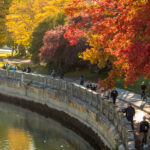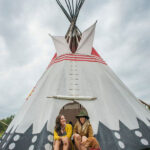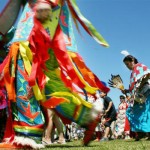Slow travel is fast catching on as travel returns. But, what is it? In a nutshell, slow travel reminds us why we travel: to discover new parts of the world, cultivate a deeper connection to unfamiliar cultures and places, and linger in one destination so we can fully experience and appreciate all it has to offer. These are among the lessons learned from the pandemic.
Slow Travel in Canada
Keeping it slow: Canada is ideal for this kind of travel – its vast, ever-shifting landscape is marked by off-the-grid nature adventures, rich urban experiences and fascinating people eager to open their doors to visitors. So choose a home base, prepare to immerse yourself and discover an entirely new side of Canada. Here are just some ideas to get you off to a slow start:
Answer the call of the wild: Visitors to Canada generally associate wildlife viewing with bears, moose and whales – but there are 80,000 species of animals in this vast country, and plenty of ways to see them in their natural habitats. Head to Notre-Dame-de-Bonsecours, Quebec, for an up-close-and-personal experience with wolves, which – aside from howling at the full moon – help to maintain healthy ecosystems. Here, stay at the sprawling 2,200-hectare Parc Omega, where a 12-kilometre self-guided safari reveals local wildlife such as elk, bison, bears, caribou and, of course, wolves. The park also boasts luxurious accommodations where guests can sleep alongside grey and Arctic wolves. Book the Wolf Lodge and Chalet, whose floor-to-ceiling windows look out to the wolves’ natural habitat, and binge on an evening show unlike anything you’d find on TV.
Go with the tidal flow: Slow travel is inherently linked with wellness – after all, staying mindful and fully present is a form of meditation, and tossing out the to-do list is great for your mental health. To amp up the wellness element of your getaway, visit the Bay of Fundy in Nova Scotia, home to the highest tides on earth, the rarest whales in the world, and semi-precious minerals and dinosaur fossils. Here, you can embark on a kayaking and yoga excursion, which starts with a guided paddle along tranquil Horseshoe Cove, where you’ll glimpse secluded coves, rugged cliffs and ancient lava flows that tell the tale of the continents’ separation. Next, you’ll arrive at a quiet lighthouse for a gentle yoga session and relaxing neck massage featuring locally made balsam fir oil, before settling in for a leisurely al fresco brunch made with fresh, local ingredients. For a different perspective of the bay, indulge in the Horseback Tidal Floor & Fossil Tour, a collaboration between the Fundy Geological Museum and Spirit Reins Ranch,which leads guests on a low-tide horseback ride across the ocean floor. Available year-round, the tour winds through the bay to an ancient fossil site, revealing 300-million-year-old fossils.
Walk, don’t run: If you’re seeking an immersive escape into nature, look no further than Prince Edward Island. Canada’s smallest province is 280 kilometres long – but you aren’t walking through, you’re walking around, so it’s going to be blissfully longer. The 700-kilometre (435 mile) Island Walk hugs the ocean, meanders along the historic Confederation Trail, and traverses red dirt roads and beaches – all while passing through an ever-changing natural landscape that will keep trekkers enthralled. The walk isn’t technically difficult, which means anyone can attempt the route. And, it’s broken into 32 sections, so if you’re not quite ready to circumnavigate the province, you can pick and choose the sections that appeal to you.
Tune into the wisdom: To learn about Canada’s rich Indigenous culture, head straight to Winnipeg, Manitoba, home to Canada’s largest urban Indigenous population. Start your visit at Qaumajug, a new museum dedicated to Inuit art and culture, which opened at the Winnipeg Art Gallery (WAG) in March 2021. The first-of-its-kind centre is home to the largest public collection of contemporary Inuit art in the world, and represents the collective vision of artists, Indigenous advisors and stakeholders. While wandering through the city, keep an eye out for bold First Nations sculptures, like a five-metre-high tea kettle big enough to hold water for 250 people, or a stylized sculpture of a pregnant woman representing Mother Earth. Visit the Urban Shaman for a glimpse at contemporary Indigenous art; or sample pickerel, bison ribs and bannock at Feast Café Bistro. As you explore Indigenous culture in Winnipeg, you’ll uncover a stronger understanding of the people who first settled in Canada thousands of years ago.
Park it right there: Jasper National Park in Alberta is the biggest park in the Canadian Rockies, sprawling 11,000 square kilometres – and yes, there’s plenty to keep you occupied for a long and satisfying getaway. First, rent a cabin that marries heritage aesthetics with modern comforts, producing an atmospheric environment you’ll want to spend all your time enjoying. When you do venture out, you’ll find trails crisscrossing the park; join a photography tour to enhance your hike with stunning photos of waterfalls, dark skies and mountain peaks. Visit the Jasper Planetarium to gaze at the cosmos through the largest telescopes in the Rockies; or canoe along the park’s turquoise glacial lakes, floating past snowcapped peaks and watching sea wildlife (and often bears, elk, deer, wolves and moose).
Slow travel meets slow food: One of the best ways to savour your time in Canada is learning about the culture, cuisine and history of the land.
For example, did you know Newfoundland and Labrador was once sustained by cod from the Atlantic Ocean? Cod fisheries became the region’s main industry and the fish was exported to the world. Local fishermen kept (and cooked) the parts no one wanted: the heads, tongues and sounds (an air bladder that keeps the fish afloat). Visitors can learn about sustainable, ethical farming in Avondale, where the family-owned Cod Sounds hosts foraging excursions demonstrating how to respectfully fish, hunt and harvest. Upcoming workshops include “Wild Game Cookery – Fur & Feathers”, which covers field dressing, cleaning and de-boning (October to May), and “Fall Berries/Wild Game”, which tickles palates with wild seaweed salts, cloudberry jam, bottled game and other local delicacies (September to October). During your stay in Newfoundland and Labrador, settle in at a pristine beach and read The Forager’s Dinner: Finding, Harvesting and Preparing Newfoundland & Labrador’s Edible Plants by Shawn Dawson, a field guide to foraging in the region’s forests, bogs, cliffsides and shorelines.
Wander and wonder in the city: One of the most connected cities in Canada, Vancouver, BC is an ideal home base for post-pandemic travel. Here, visitors can wander city-in-nature attractions like Capilano Suspension Bridge Park, Grouse Mountain and Stanley Park; spend leisurely hours in farm-to-table eateries that prioritize organic and responsible food sourcing (try The Acorn and Forage, for starters); and stay in hotels that offer full-blown cultural experiences, not just a bed to lay to your head (The Douglas, An Autograph Collection Hotel and Fairmont Pacific Rim are top picks). Beyond city exploring, rent a car and drive the scenic Sea to Sky Highway to Whistler for adventures in the mountains, forests and village centres; or, head to the fertile Okanagan Valley, whose wineries, farm stands and sparkling lakes keep the pace relaxed.
























Speak Your Mind